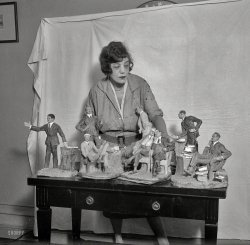
MAY CONTAIN NUTS

Search Shorpy
SHORPY ART

Framed or unframed, desk size to sofa size, printed by us in Arizona and Alabama since 2007. Explore now.
Join and Share
Ad-Free Shorpy
Shorpy is funded by you. Patreon contributors get an ad-free experience.
Learn more.

Recent comments
- Treescaping
- +112
- Rear View
- Way in the back --
- Button It Up
- And with an eye on the time ...
- Working in an enclosed ashtray
- Rear View Mirror?
- Tobacco cam
- Basic fact I learned only later in life
- Put a Lid on it!
- Pinstripes in the Tower
- Sound enhancement
- 3438 in '38
- Second Career
- Their days are numbered
- Only the Sensor
- Train control mechanism
- Rarest of the Rare?? & Classy 3400 Class
- Control Mechanism
- Those standpipes
- Wrenches
- International D-40 I believe
- Job prospects
- You had me at Train
- Land of the free
- Broad-Exchange Bldg
- Parking innovation
- The old block
- "Peck turned a sweet propeller"
Member Photos
The Shorpy
Printporium
Printporium
Search Shorpy
Search results -- 30 results per page
- Thankful Smiths: 1941
- ... of the attitude seen at our Thanksgiving dinner last night. Wish I had a photo to remind me, like these folks did. The ironic sight ... Posted by Dave - 11/22/2018 - 3:20pm -
![Thankful Smiths: 1941 April 1941. "Family of Lemuel Smith, Farm Security Administration borrower, saying grace at the afternoon meal. Carroll County, Georgia." Medium format acetate negative by Jack Delano for the FSA. View full size.
Improvised placematfor the baby, who obviously is expected to make a mess.
Lemuel and Susie lived long livesAccording to the records accessible through Ancestry, the Smiths were 40 and 38 in 1940, and had seven children. Lemuel and Susie lived to be ~94 and 86, respectively.
Happy ThanksgivingWhat a beautiful photo of an Americans during difficult times! Maybe poor in finances, but clean and a great family.
Doubly blessedCornbread AND biscuits.
Like homeThis photo reminded me somewhat of the attitude seen at our Thanksgiving dinner last night. Wish I had a photo to remind me, like these folks did. The ironic sight of oil lamps and an electric iron, both atop the pie safe, is pretty charming here, too.
Yeah we have it tough these days 2018they did not know they were poo in the sense, it will get better in the future let it not drag us down, of course religion was just aboiut the paramount of their lives unfed all trying times.
[The poo will always be with us. - Dave]
Happy Thanksgiving Shorpies!! Time to play "guess the food". I'm not very good at the game so may need help from fellow Shorpies. I see:
Cornbread ( and lots of it )
Green beans
Rolls
The adults and 2 older children are drinking coffee or tea?
Raisin pudding?
A plate of chicken?
A large mason jar of ... salad dressing?
A large bowl of gravy?
Sugar bowl in the center?
Everybody has a bowl of ... cranberry sauce? ( I have thanksgiving on the brain.)
AcmeWile E Coyote's brand of choice.
(The Gallery, Jack Delano, Kids, Kitchens etc.)](https://www.shorpy.com/files/images/SHORPY-8c05287a.thumbnail.jpg)
- Half Past: 1907
- ... Portsmouth. The church is still there, and is lit up at night.
Seen previously on Shorpy ... here and, in the distance, ... Posted by Dave - 05/02/2015 - 10:53am -
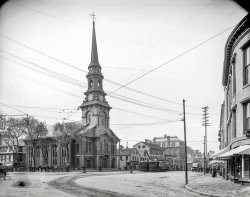
- Newsstand Noir: 1957
- ... Ford F-100. And not to forget the Friday and Saturday night cruises where the county gathered from Highway 101 to Foster's Freeze and ... Posted by tterrace - 05/21/2015 - 1:26pm -
![Newsstand Noir: 1957 My brother snapped this 35mm Kodak Tri-X negative as a former high school classmate left (Fled? Took it on the lam?) from this newsstand at 1241 Fourth Street in San Rafael, California. At the time this was one of two newsstands downtown. That was in addition to Montgomery Ward, J.C. Penney, Macy's plus all the other kinds of stores that made San Rafael the major shopping spot for Marin Country - that is, until shopping centers started popping up a few years later.
If I didn't know better, I'd think that guy might have been Elvis. View full size.
Speaking of parking metersI remember one evening a bunch of us were hanging out at the Foster's Freeze when a car, obviously out of control, jumped the curb and knocked down a parking meter (at the same exact place incidentally that the cop car was de-axled in "American Grafitti"). The car backed up and sped away at which time we dashed for the meter and took it up the hill to disgorge its contents. After an hour of bashing it refused to give up its booty and for all I know the meter is still up on the hill in back of Foster's Freeze. Our adventure didn't make it into the movie.
Fourth Street holds many memoriesThe Rafael Theater where some serious necking was done. Next door, the Navy recruiter where I solemnly vowed to protect my country in 1962. J.C. Penney's where I bought most of my clothes. The two auto parts stores across the street from each other where I furnished my 1957 Ford F-100. And not to forget the Friday and Saturday night cruises where the county gathered from Highway 101 to Foster's Freeze and back again countless times. It was a great place to spend my senior year.
2 things you don't see anymoreTypewriters
Parking meters
White wall tires
Barber poles
[And then some. -tterrace]
Parking metersDon't know about whitewall tires, barber poles or typewriters, let alone Elvis, but downtown San Rafael is still loaded with parking meters. No Cool Hand Lukes roaming around lopping them off with a pipe cutter though.
Body languageThat looks like the pose taken by my high school pals when leaving a store that had sold beer to the underaged. You know, hiding it under the coattail as if nobody would notice it or him. Saw it a hundred times, hehe.
Elvis confusionI have to agree with your comment about Elvis; at first glance I thought it was him too. I don't doubt it will eventually find its way into the fan circles misconstrued as a long-lost unreleased candid. Cool pic nonetheless.
(ShorpyBlog, Member Gallery, tterrapix)](https://www.shorpy.com/files/images/newstandnoir.thumbnail.jpg)
- Hot Texas Wieners: 1939
- ... one, perhaps to inhibit table-hopping by ladies of the night. I was once forcibly evicted from Bassin's (12th and Penn, NW, and long ... Posted by Dave - 09/20/2017 - 12:29am -
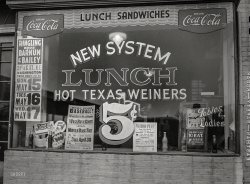
- Shadowland: 1907
- Circa 1907. "Pittsburgh by Night." Our second nocturnal view of the Steel City. 5x7 inch dry plate glass ... Posted by Dave - 08/05/2012 - 4:13pm -
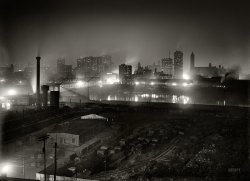
- Delicious Cakes: 1922
- ... household exposition, which opens at 7:30 o'clock tomorrow night in Convention Hall , Fifth and L streets northwest, and continues for ... receive final instructions.
After the opening tomorrow night, the show will be open daily, except Sunday, from 3 to 5:30 and 7:30 to ... Posted by Dave - 09/11/2011 - 6:47pm -
![Delicious Cakes: 1922 Washington circa 1922. "Food show. Ward exhibit." Among the tempting varieties of Ward's Cakes on display here: Silver Queen, Devils Dream, Kukuno, Creamy Spice, Sunkist Gold and Southern Pride. Plus Paradise Fruit Cake and something called "Homelike." View full size. National Photo Company glass negative.
What, no penathalenoleum?Store-bought cakes that actually look like they taste good, rather than the weird aftertaste and bloating you get from today's preservative-laden science projects. This is the first Shorpy photo that made me hungry. Well, OK, the second… after the possum gloop splattered into the gutter.
Food Show Exhibitors
Washington Post, Feb 4, 1923
60 Exhibits Prepared for Pure Food Show
Convention Hall Converted Into Dazzling Picture
for Opening Tomorrow
Sixty exhibits and practical demonstrations of pure food products and labor-saving devices for the home are scheduled for the national food show and household exposition, which opens at 7:30 o'clock tomorrow night in Convention Hall, Fifth and L streets northwest, and continues for two weeks.
The hall has been converted into a veritable fairyland with rows and rows of dazzling booths and yards and yards of artistically draped bunting. Salesmen and demonstrators will gather at the hall tomorrow morning to receive final instructions.
After the opening tomorrow night, the show will be open daily, except Sunday, from 3 to 5:30 and 7:30 to 10:30 p.m. Everyone will be given plenty to eat free -- coffee, tea, milk, soft drinks, "hot dogs," pancakes, salads, gelatine, cheese, salad dressing and other things.
The list of exhibitors follows:
France Milling Co. (Gold Medal Pancake Flour)
Joseph Tetley & Co.
Gelfand Manufacturing Co.
Browning & Bains Coffee Co.
Steuart Sons & Co. (sirup [sic] and molasses)
Foulds Milling Co. (macaroni and spaghetti)
Carry Ice Cream Co.
Noxzema Chemical Co.
Johnn B Heppe & Co.
E.J. Agee (Economy Darner)
Cheek Neal Coffee Co. (Maxwell House Coffee)
J.L. Kraft & Bros., Inc. (cheese)
Akin Manufacturing Co. (Shi-Nall)
Brewer Snyder Co.
A. Loffler Provision Co.
Corn Products Refining Co. (Parko)
O.J. DeMoll & Co. (pianos and talking machines)
Nelson Refrigerator Co.
Refrigerator Pan Alarm Co.
Rosslyn Packing Co.
Golden & Co.
National Furniture Co.
Corby Baking Co.
Hacker Cereal Co.
Thomas J. Lipton, Inc.
S. & S. Water Co
Genesee Pure Food Co. (Jell-O)
Wilkins & Rogers (butter)
Palmer Harvey & Co.
Walker Hill Dairy
C.F. Mueller Co.
Julius Lansburgh Furniture Co.
McCormick & Co.
Martin Gillet & Co. (House of Lords Tea)
P.B. Davis Co. (Davis Baking Powder)
S. Kann Sons Co. (modern kitchen utensils)
Hub Furniture Co.
Chapin Sacks Inc.
Mutual Service Bureau (electrical devices)
Kirkman & Son
Carroll Erwin Co. (electrical household goods)
Columbia Bottling Works
William Conradis & Co. (model bath room)
New Era Gas Stove Co.
Pillsbury Flour Mills Co.
King Electric Washer Co.
Ward Baking Co.
Doubleday Hill Electric Co. (radio receiving station)
Cook's Quality Cakery
Harry Chapel (broker)
Troco Nut Butter Co.
William T. Leahey & Co. (vegetable cutters)
Havenner Baking Co.
Ridgewood Orchards (apple)
and several additional exhibitors to be definitely announced tomorrow.
(The Gallery, D.C., Natl Photo)](https://www.shorpy.com/files/images/30186u.thumbnail.jpg)
- Happy Family: 1954
- ... any film. The image of her running up the highway in the night in stark fear immediately sucks the audience into the drama before the ... Posted by Dave - 06/08/2016 - 1:15pm -
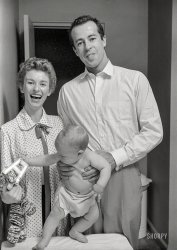
- And Baby Makes Three: 1940
- ...
The Wreck of Old Number Nine On a cold winter's night, not a star was in sight --
Miscellany Looks like a dried palm ... Posted by Dave - 04/06/2020 - 1:41pm -
![And Baby Makes Three: 1940 August 1940. "Family in Mauch Chunk, Pennsylvania." Medium format acetate negative by Jack Delano for the Farm Security Administration. View full size.
The Wreck of Old Number NineOn a cold winter's night, not a star was in sight --
MiscellanyLooks like a dried palm frond between the organ and the back wall. Also someone dropped a pencil to the floor. It's behind the stool.
[Also a match on the mat. - Dave]
They could have burned the place down.
Catholic familiesoften will display a palm frond received at mass on Palm Sunday. They are collected and burned the following year for Ash Wednesday to mark the faithful. Additionally, one photo displayed on the organ looks like a lady who has just received the sacrament of confirmation judging by her approximate age, veil and white dress.
Palm SundayI like the Easter season because it’s spring and the time of my own son’s birth and the holiday makes people happy. The weekend before, I’ve always taken pleasure in spotting people in the streets with palm fronds from the church service for Palm Sunday. It was a definite mark of our current virus crisis that I saw no palm fronds this past Sunday. And when I asked an RC friend how she takes the Sacrament without actually going to church, she told me that the remote version of it must now suffice: it takes place in your heart.
Happy Easter to everyone in these strange and challenging times!
Re: Catholic familiesActually, the photo is of a young girl, most likely the woman pictured, in her First Communion dress. Catholics receive First Communion about the age of 7. Confirmation is a separate sacrament, received in the teen years, after a two-year instruction period.
Holy FamilyNo matter which painting of the theme I look at it, and no matter which trio of mother and father and baby I see in real life, every time I look at the painted version of the Holy Family, I think of your basic young family with a single infant, and vice versa.
Parlor organLooks to me like a Mason & Hamlin reed organ from the 1890s. Or something very similar.
(The Gallery, Jack Delano, Kids)](https://www.shorpy.com/files/images/SHORPY-8c02887a.thumbnail.jpg)
- West Side Story: 1959
- ... playing stickball on street; on streets during day and night; playing pool and basketball at a community center; making boxes in a ... Posted by Dave - 12/18/2021 - 11:37am -
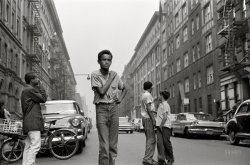
- Laurel in the Pines: 1901
- ... sleeping in a tot cot outside my parents' room, our first night at this grand and imposing hotel. I awoke in the night, and called out sleepily: "Mommy, I smell burning". Trusting my sense of ... Posted by Dave - 07/03/2018 - 1:44pm -
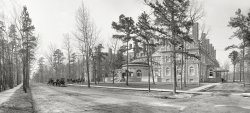
- Hi-Fi 1954
- ... of I think. Dad and I spent about an hour or two each night for what seemed forever building it. We had built an oscilloscope prior ... listening to WLS (I think that was it) in Chicago at night. I used that receiver right up till I went in the army in 73.
... Posted by tterrace - 09/22/2011 - 7:20pm -
![Hi-Fi 1954 My brother's do-it-yourself hi-fi. From Top: tweeter, woofer, Webcor portable phonograph, Heathkit amplifier. One of his high school buddies assembled the Heathkit for him. He took this in the upstairs bedroom we shared until a year or so later. That's my bed on the right. Check out our cool wallpaper. View full size.
HeathkitI can't begin to count how many Heathkits and Knight-Kits I built over the years. It's another lost art -- no one builds kits anymore. Electronic parts are so tiny these days you can barely see them, much less handle them. It's all done by machines.
Heathkit Memories (Egads)My dad built a Heathkit television, he started in the mid/late 70's. I'm pretty sure he never really finished it. I don't wish to knock Heathkit because it never really worked, but that could be because of Dad's skills.
Iit did work for a while, but not for long. At one point Dad decided it needed a remote control, so he built one.
Using an incredibly long highway of that rainbow wire strip, attached to a black plastic box with a metal face. It had two buttons, using that labeling tape - ON and the other OFF.
When I was 10 I thought it was pretty spiffy, really.
HeathkitMy father and I built 4 Heathkit televisions and numerous other kits. With a kit that large it took a bit of determination to troubleshoot a problem but Heathkit provided good tech support and if necessary would repair/build your kit if you had problems.
Shortwave radioFor one Christmas in the early 60's my folks got me a Heathkit shortwave receiver kit. This was back when FM was still unheard of I think. Dad and I spent about an hour or two each night for what seemed forever building it. We had built an oscilloscope prior to that. I don't ever recall what we used the scope for though it stayed with the family for decades and finally found a dumpster just after Dad's passing in 2000. The radio was fantastic though. We strung a 50 foot antenna across the back yard and I remember listening to WLS (I think that was it) in Chicago at night. I used that receiver right up till I went in the army in 73.
[Wouldn't that be AM, not shortwave? As for FM broadcasting, there were hundreds of FM stations by the early 1950s. - Dave]
(ShorpyBlog, Technology, Member Gallery, tterrapix)](https://www.shorpy.com/files/images/hifi.thumbnail.jpg)
- Peer Pressure: 1942
- ... neck for flipping me off at the first aid class the other night.
(The Gallery, Education, Schools, Medicine, Russell Lee) ... Posted by Dave - 04/23/2022 - 5:10pm -
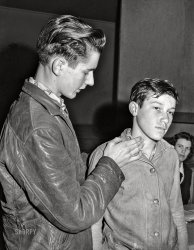
- Heavy Metal: 1920
- ... burner in the Union Crawford kitchen range. After a night of water heating, the temperature/pressure relief valve would sometimes ... Posted by Dave - 09/04/2012 - 2:43pm -
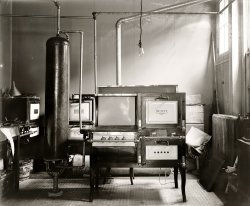
- Llano de San Juan: 1940
- ... creepiest That is the creepiest church. Imagine, at night.
Llano de San Juan What is amazing is how this image could have ... Posted by Dave - 08/30/2012 - 2:01pm -
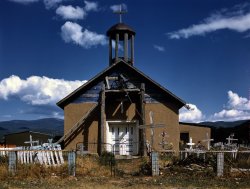
- Housing Boom: 1923
- ... marble steps and friendly neighbors made a humid summer night somewhat bearable.
We kids would play games of Red Line and Hide And ... Posted by Dave - 09/11/2011 - 1:18pm -
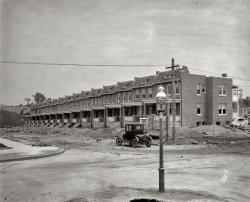
- The 24-Carrot Kitchen: 1954
- ... be in this shot? Dude looks like he tied on a few the night before. Your modeling days are behind you, buddy.
1950s Prophecy ... Posted by Dave - 11/19/2018 - 8:14pm -
![The 24-Carrot Kitchen: 1954 1954. "Harley Earl, General Motors Vice President of Design, in Frigidaire's 'Kitchen of Tomorrow' exhibit for the GM Motorama at the Waldorf-Astoria Hotel in New York." Flanking the Range of Tomorrow we have, on the right, the Rotisserie Oven of Next Wednesday; on the left, stowed in the down position, is an "Electronic Oven," which is what they called microwaves back in the day. Color transparency by Arthur Rothstein for Look magazine. View full size.
Frigidaire FlairWhen I bought my house 22 years ago I thought that bizarre oven/stove combo would be the first thing to go, but I'm still using it! Previous owners were kind enough to leave both pics of the house from a Better Homes article from 1941 and the original brochure for the stove, among other things. The lady on the cover of the brochure is wearing a dress, high heels, and a CROWN while using the fancy new appliance! One major downside is the interiors of those ovens are chrome and therefore nearly impossible to clean.
BewilderedMr. Earl looks ... uncomfortable.
"What do you expect me to do with these carrots? I'm a car designer."
Always wondered what motivated GM to get into appliances.
[Zillions of dollars in profits? - Dave]
And here it isCourtesy of Google Books, here's an article on the Motorama kitchen, from the April 1954 issue of Popular Science.
Paging Jackie GleasonWe desperately need "The Chef of the Future" to complete this scene.
Visine, pleaseGod bless him, but who decided Harley Earl should be in this shot? Dude looks like he tied on a few the night before. Your modeling days are behind you, buddy.
1950s ProphecyTomorrow is like today only in stainless steel.
A gadgety timeIn the early 1960s my parents renovated their 1920s Colonial home outside of Detroit. The kitchen especially received much attention with a fresh coat of orange paint (so much orange) and a space-age Frigidaire Flair double oven with pull-out cooktop.
Futuramic CarrotsHarley Earl was fixated on the future, at least in his own areas of operations.
I believe he is scrutinising the carrots, trying to visualize the carrot of 1957 if GM should make the logical move from stoves to vegetables.
Should it be straightened, or should we just make the curve more controlled? Fins?? and those leaves desperately need some organization!
(The Gallery, Kodachromes, Kitchens etc., LOOK)](https://www.shorpy.com/files/images/SHORPY-12349u1.thumbnail.jpg)
- Police Woman: 1955
- ... marks during the day, "at home cooking and knitting" by night. Looks like a scene from a fifties film noir. Suspect regrets sending his ... Posted by Dave - 03/31/2022 - 1:41pm -
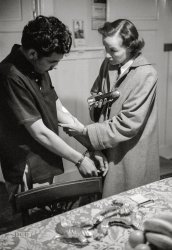
- Mills House No. 1: 1905
- ... building had 1,560 tiny rooms that rented for 20 cents a night. 8x10 glass negative, Detroit Publishing Co. View full size.
In ... in 2012. Which would still be ridiculously cheap for a night's lodging in The Big Apple.
Ahh, the Village Gate Lots of great ... Posted by Dave - 11/23/2012 - 10:37am -
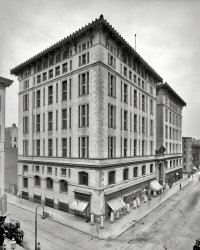
- Needle's Eye: 1943
- ...
The Joads, of course, drove past this place at night, after spending the searing hot desert afternoon immersed in the Colorado ... Posted by Dave - 03/01/2014 - 10:14am -
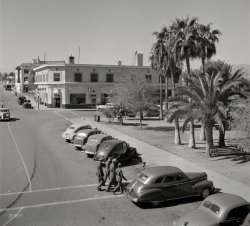
- Bessie Hicks: 1911
- ... to one of Bessie's granddaughters for nearly an hour last night. Bessie lived for 81 years. It appears that the "store" she was planning ... Posted by Dave - 09/08/2011 - 6:22pm -
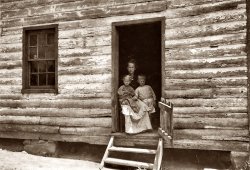
- Last Stop: 1901
- ... was moved to a museum.
Superstorm -116 years On the night of October 29th 1896, a hurricane hit Savannah causing the cemetery to be ... Posted by Dave - 10/31/2012 - 10:08am -
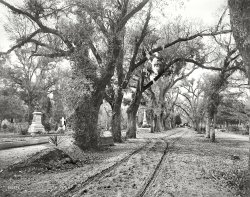
- A Pretty Grille: 1941
- ... looks like clear plastic and just might have lit up at night.
Barn Find Reminds me of an urban legend current when I was young ... Posted by Dave - 12/29/2014 - 2:28pm -
![A Pretty Grille: 1941 San Francisco, 1941. "Pontiacs being unloaded from freight cars." Slathered with chrome. 8x10 Eastman Kodak Safety Film negative. View full size.
Last of the New Cars for ConsumersI'm supposing that these are being unloaded not long before the attack on Pearl Harbor.
These represent the last model year of new cars available to consumers until World War 2 was finished. Sales of new automobiles were severely limited for the duration.
[You're a year off. These are 1941 Pontiacs; 1942 was the last model year for new cars before the war. - Dave]
Note that the Pontiacs are being unloaded from special end-door RR boxcars. The boxcars shown have now-obsolete features such as full-height ladders and roof walks. Examining the boxcar doors close up will reveal minor damage.
Autos are still shipped extensively by rail, but the current auto carriers have three decks!
Put them back in the freight carThen wait 75 years and open it again.
What a time capsule that would be!
Illuminating?I refer to the hood ornament which looks like clear plastic and just might have lit up at night.
Barn FindReminds me of an urban legend current when I was young in Minnesota circa 1980. A boxcar (or two, or three) filled with 1949 Hudsons or '42 Chevys or (fill in dream car here) was found, lost by the railroad for decades, on a siding in Michigan or Ohio or Canada. Ah, well. Great photo.
Chief Pontiac's faceDid not light up until 1949.
Bryant StreetBuilding in background is the Hamm's Brewery at 1550 Bryant Street. See this photo across railroad loading docks. My guess is that the photo was taken at the former site of the Southern Pacific 16th Street freight depot, located around Treat Street between Florida and Harrison. The Shorpy photo and the one below both appear to be from around Treat Street. looking towards Florida. A 1960s track diagram for the Southern Pacific doesn't indicate a match for the freight sheds and ramp for unloading (see Zone 8 page 1). The track diagram does indicate track 828 was the "old 16th Street Freight Depot," suggesting the tracks had been rearranged before 1960.
Interesting story here.The type of railroad car is an "end door" type. They were designed for carrying automobiles, or larger loads. The end doors were only on one end though, meaning that to unload, you had to move the cars around after each was emptied. Bout twenty years ago, in a small town in Georgia, they stumbled across three of these cars abandoned in an old yard. Took some working to figure out, but the cars had apparently been lost in transit to a local dealership in Savannah. Sidelined due to something wrong with the trucks (bogies the cars ride on.) The cars were just forgotten. Well, when the crews found them, they asked what to do and were told to just scrap them. Opening the doors, they found that each car held three brand new Ford Galaxies, with all of six miles on the odomoter. The owner of the company doing the demolition took two for himself, and divided the remaining cars among his crew. One of the cars sold at Barret's auto auction some years back, with the winning bid being over one million dollars.
(The Gallery, Cars, Trucks, Buses, Railroads, San Francisco)](https://www.shorpy.com/files/images/SHORPY-171-01.thumbnail.jpg)
- Death Car: 1923
- ... 50 years old, 477 C street southwest, was identified last night at the morgue as the second victim of the accident which carried an ... Posted by Dave - 09/12/2011 - 12:11pm -
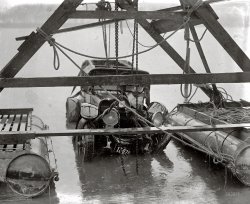
- Marlene: 1952
- ... a DVR'd documentary from Turner Classic Movies just last night called "Cinema's Exiles: From Hitler to Hollywood" (2009), about the huge ... Posted by Dave - 05/12/2016 - 3:25pm -
![Marlene: 1952 March 1952. "Marlene Dietrich makes her stage debut in Chicago." Color transparency by Phillip Harrington for Look magazine. View full size.
The Sharp Eye of ShorpyHaving been a publisher of magazines for 25 years, I agree tterrace is right that printing would smooth this out a great deal, with all those Ben Day dots.
I hadn't noticed until just now taking a second look at this Shorpy-Sharp photo that Dietrich employed the same makeup tactic as Lucille Ball (and others) -- painting in lips far larger than nature provided, with the upper lip drawn well above the natural line. I imagine one would rarely see a photo of either Dietrich or Ball without that artifice. I've found only one photo of Ball with the natural lip line and she was truly not recognizeable as the icon we all know.
My aunt worked in pictures in the 50s and said no one would recognize Betty Grable without her makeup, but said Marilyn Monroe was naturally beautiful without hers.
This picture makes me realize why Dietrich liked Von Sternberg's "butterfly lighting" and reckon that black and white was something of a blessing for her (though Dietrich in her first Technicolor, "The Garden of Allah", was spectacular).
Absolutely FabulousAs Edina in the UK sit-com AbFab says "My entire body hangs off these cheekbones!"
Before plastic surgeryTons of pancake makeup.
The seat of glamourShe appears to be sitting on a vinyl-and-chrome chair from a dinette set.
But under all that Max Factor, a fine soulI watched a DVR'd documentary from Turner Classic Movies just last night called "Cinema's Exiles: From Hitler to Hollywood" (2009), about the huge number of film-making refugees from Germany just prior to WWII, in which she featured prominently. Most of the points made about her in that film are made in the Wiki biography about her. As an old fan, I already knew most of anyway, and while I admit that the heavy makeup is the first thing I noticed in this photo of her at age 51, my immediate next thought was that her inner beauty of strength of character and humane ethics needed no makeup or embellishment. She was right among the first to open her home to refugees and get them into jobs and homes of their own, and was right at the top in sales of war bonds and among the most hardworking entertaining the Allied troops around the world. The vanity of a bit of makeup and later a bit of plastic surgery seem trivial amid such a life lived in anything but vain. Living gracefully is more rare and important than the superficiality of "aging gracefully".
I confess stereo wars with my sister during high school involved me listening to Dietrich in my room and my sister listening to Led Zeppelin in hers.
Before the touch-upLooks like a photographer's proof before the touch ups are done.
[It's not a "proof" because this is a scan of the camera original. The magazine's color printing process alone would smooth everything out a good deal. -tterrace]
Wrong terminology.I think the magazine publisher in an earlier comment used the wrong terminology. Ben-Day dots differ from halftone dots in that the Ben-Day dots are always of equal size and distribution in a specific area. To apply the dots to a drawing an artist would purchase transparent overlay sheets. Photographs and artwork are converted to halftone dots for reproduction, whether it be for letterpress or offset production. Yes, sometimes they will tend to lose detail especially when using a coarser line screen. I've been a graphic designer for over 40 years.
(Kodachromes, LOOK, Phillip Harrington, Portraits)](https://www.shorpy.com/files/images/SHORPY-08747u.thumbnail.jpg)
- Chase the Chills: 1920
- ... suffocate. Grandma would turn off all the heaters at night and we'd be buried under at least 4 handmade quilts. Of course winters ... Posted by Dave - 03/16/2015 - 2:36pm -
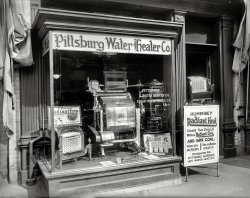
- Tashmoo at the Dock: 1900
- ... high point in the boat's eventful 36-year life was the night in 1927 that she broke free of her moorings in a winter storm and headed ... Posted by Dave - 07/26/2012 - 12:32pm -
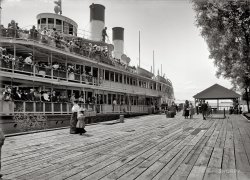
- Truck Parade: 1919
- ... peace monument.
At the close of the entry lists last night more than 400 trucks had been nominated for today's parade, the biggest ... Posted by Dave - 07/17/2012 - 10:29pm -
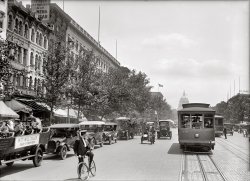
- A Little Game: 1897
- ... entire time we were at sea. If it was your turn to play at night, the firewatch would wake you up. There were some good players that would ... Posted by Dave - 07/29/2012 - 6:14pm -
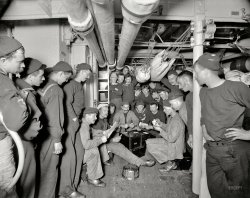
- Rainey's Harley: 1922
- ... stretcher bearers got Rainey back to a base hospital.
Night before last Private M.A. Rainey, of the United States Park police, was ... Posted by Dave - 04/06/2013 - 11:48am -
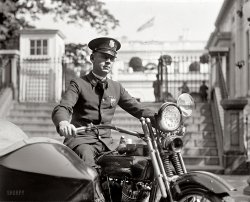
- Public Figures: 1929
- ... would I be willing to sleep with them in the same house at night?
I don't think so.
True to the Nom de Plume I thought that was ... Posted by Dave - 05/30/2013 - 3:37am -
